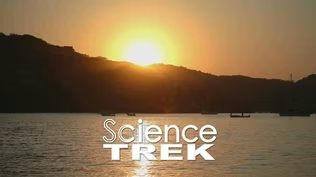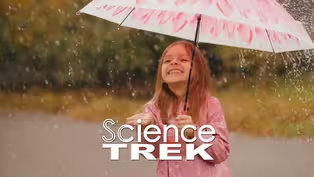
Weather: Meteorologists At Work
Special | 5m 13sVideo has Closed Captions
How do meteorologists forecast the weather?
Scientists study the weather lots of different ways. What's a high or a low front? How does air pressure affect the weather? What makes the wind blow? Find out how meteorologists do their job.
Problems playing video? | Closed Captioning Feedback
Problems playing video? | Closed Captioning Feedback
Science Trek is a local public television program presented by IdahoPTV
Major Funding by the Laura Moore Cunningham Foundation and the Idaho National Laboratory. Additional Funding by the Friends of Idaho Public Television and the Corporation for Public Broadcasting.

Weather: Meteorologists At Work
Special | 5m 13sVideo has Closed Captions
Scientists study the weather lots of different ways. What's a high or a low front? How does air pressure affect the weather? What makes the wind blow? Find out how meteorologists do their job.
Problems playing video? | Closed Captioning Feedback
How to Watch Science Trek
Science Trek is available to stream on pbs.org and the free PBS App, available on iPhone, Apple TV, Android TV, Android smartphones, Amazon Fire TV, Amazon Fire Tablet, Roku, Samsung Smart TV, and Vizio.

Science Trek
Science Trek is a place where parents, kids, and educators can watch short, educational videos on a variety of science topics. Every Monday Science Trek releases a new video that introduces children to math, science, technology, engineering, and math (STEM) career potentials in a fun, informative way.Part of These Collections

Earth Science
Earth Science is the study of the earth. Learn about the place we call home.
View Collection
Careers in Science
Interested in a career in science? See what some scientists do when they go to work.
View CollectionProviding Support for PBS.org
Learn Moreabout PBS online sponsorshipJoan Cartan-Hansen, Host: Meteorologists have lots of ways to study the weather.
Let's see what they do to figure out how much it rained and what the weather will be tomorrow.
[MUSIC] John Jannuzzi, NOAA: Well, we use a funnel!
And we funnel the rain from the bigger circle down into a smaller circle, and then we can measure it that way.
So, this is a funnel that we use.
This is an eight-inch gauge, and the area of this circle is ten times bigger than the area of this circle.
So if we collect rainfall in this circle and we have it funnel into this circle here, well then, if I get what would normally be on a normal ruler in a jar measuring rainfall to one inch we would get it here so one inch would get magnified in this tube up to this height here.
So we could stick this ruler in here and it would come out and we would see that it would be wetted all the way up to this point here for one inch of rainfall and a hundredth of an inch, it would be just impossible for us to read on a normal ruler ends up being a little bit bigger here.
Certainly bigger that you can see in one of those little marks there.
Each one of those is a hundredth of an inch.
Student: Why do you need to know how much it rains?
Jannuzzi: Well, there are a lot of people who are interested in knowing how much the rain is and why.
A farmer needs to know how much rain he's going to get to know how much water he might need to add for his crops, because he's going to have to irrigate for whatever amount that Mother Nature doesn't give him in the way of rainfall.
The rivers are going to rise depending on how much rainfall we get and that's important for people who live along rivers and those who operate the dams, especially in the springtime, want to know how much water to hold back for summer irrigation.
So, measuring the rainfall and knowing exactly how much we got makes a lot of difference for agriculture, other businesses, and persons who do a lot of the operations of dams and other things in the area.
This is a weighing rain gauge, and this works like your bathroom scale, except instead of weighing people, it's weighing water.
A certain volume of water always weighs the same amount.
We can weigh the water instead of measuring the depth of it, and from that we can convert and figure out how much the rain actually was.
Student: What do you do with all this information?
Jannuzzi: The meteorologist uses this information for a lot of things.
First of all, we forecast how much rainfall we expect to have occurred because people need to know that and so we want to be able to do a good job in our weather forecasting.
So, we want to know that information ourselves so that the next time there is a storm event coming we can do an even better job.
Student: How do you know what's happening above the ground?
Jannuzzi: The way we find out what is going on through the atmosphere is to use an instrument attached to a weather balloon.
This is what we call a radiosonde.
It's a little mini weather station.
It's in a little box.
And inside this box is a thermometer, a humidity sensor and a pressure sensor, and a radio transmitter.
And the radio transmitter is sending back signals of what this instrument is measuring as it is being pulled up by a weather balloon.
[BALLOON INFLATING] Cartan-Hansen: Scientists inside the weather station can track the information being sent back by the weather balloon.
Jannuzzi: This is a plot.
Have you ever done a graph in school?
Ever graphed any data in math or science?
Well, that's what this is.
This is height along this axis and this is temperature along this axis.
So this is the measure of the temperature as the balloon went up this morning and this is the measure of dew point temperature or how it measures the humidity- how much moisture there is in the air.
At first, the instrument was measuring warmer and warmer temperatures as it first went up till it got to this point and then as the balloon kept going up it got colder and colder and colder.
Cartan-Hansen: So, meteorologists take all this information gathered with rain gages, weather balloons, even infrared satellite images.
And then try to predict what will happen in the next day, or week, or even the next few years.
They compare what they predicted with what actually happened and use that information to do a better job of forecasting the weather the next time.
If you want to learn more about the weather, check out the science trek website.
You'll find it at science trek dot org.
[MUSIC] ANNOUNCER: Presentation of Science Trek on Idaho Public Television is made possible through the generous support of the Laura Moore Cunningham Foundation, committed to fulfilling the Moore and Bettis family legacy of building the great state of Idaho.
By the Idaho National Laboratory, mentoring talent and finding solutions for energy and security challenges, by The Friends of Idaho Public Television and by the Corporation for Public Broadcasting.
Video has Closed Captions
Clip: Special | 1m 4s | How do blobs of air create storms? (1m 4s)
Video has Closed Captions
Clip: Special | 1m 4s | What is air pressure? (1m 4s)
Providing Support for PBS.org
Learn Moreabout PBS online sponsorship
- Science and Nature

Explore scientific discoveries on television's most acclaimed science documentary series.

- Science and Nature

Capturing the splendor of the natural world, from the African plains to the Antarctic ice.
Winnipeg In Bloom











Support for PBS provided by:
Science Trek is a local public television program presented by IdahoPTV
Major Funding by the Laura Moore Cunningham Foundation and the Idaho National Laboratory. Additional Funding by the Friends of Idaho Public Television and the Corporation for Public Broadcasting.


